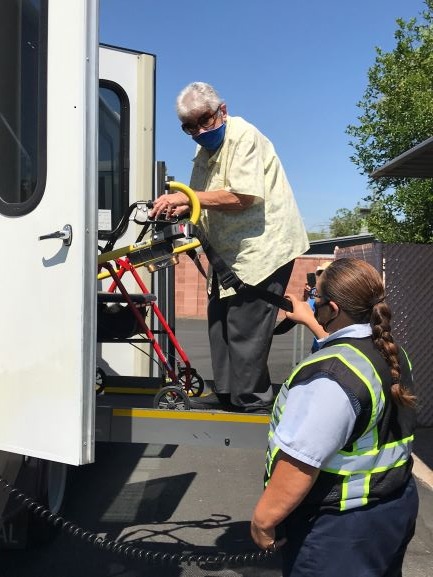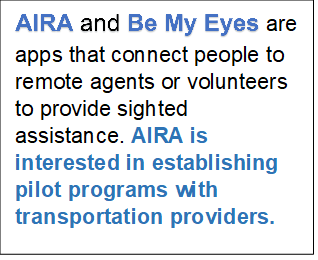The Impact of COVID-19 on Transportation: Issues and Solutions for People with Vision Loss
This is the Second of two blogs reporting the results of a national survey conducted by the American Foundation for the Blind (AFB) to shine a light on ways in which the COVID-19 pandemic has impacted people with vision loss. Part 1 focused on challenges. Part 2 identifies issues and solutions. Thank you to AFB guest blogger Neva Fairchild, National Aging and Vision Loss Specialist, and to Pris Rogers, Special Advisor on Aging and Vision Loss and L. Penny Rosenblum, Director of Research.

A woman using a walker boards a paratransit vehicle using the lift. Credit: AFB
In the previous blog, we discussed the “Flatten the Inaccessibility Curve ” survey that the American Foundation for the Blind, along with 14 other vision-related U.S. organizations and companies, completed to determine the impact of the COVID-19 pandemic on people who are blind or visually impaired. As noted, 1,921 individuals completed the survey; 1,162 (60%) chose to answer questions related to transportation, more than any other optional section.
This blog delves into issues and solutions brought out in 176 pages of comments about transportation. This participant captured the concerns of many respondents:
“How are we going to focus on better policy change long-term? Because this thing [COVID-19] isn’t going away anytime soon… and we can’t be forgotten. It’s bad enough we’re still fighting for the basics of the ADA, [which] passed 30 years ago. And still with that, we are left behind compared to other disability groups.”
The issues are divided into those existing prior to COVID-19, but exacerbated by the pandemic, and those that occurred as a result of the coronavirus.
Issues Existing Prior to COVID-19
- Lack of rural transportation.
- Lack of accessible information about transportation schedules.
- Inaccessibility of apps for managing bus schedules, payment, etc.
- Public fear of and misconceptions about blindness, guide dogs, etc. (now exacerbated by the fear of getting the virus from a dog).
- ADA protections ignored.
- Grocery bag limitations on paratransit.
- Lack of transportation options on weekends.
- Not having a voice when transit decisions are being made by public entities.Bus announcements hard to hear or understand, now worsened by distancing of driver from riders.
- Necessity to go to several stores to find supplies, which is hard to do with public or paratransit and more expensive with ride share; with COVID-19, this is almost impossible yet critical due to shortage of supplies such as toilet paper.
Issues Resulting from the Pandemic
- Safety issues related to physical contact—regardless of form of transport; sighted guide; cleanliness of vehicle; closeness of driver/passenger; inability to see if other passengers are wearing protective gear.
- Cost of transportation for rideshare has gone up as well as concern that rideshare companies will go out of business or cut back, further limiting options.
- Lack of medical transport. Requirement to wait in car for medical and other types of appointments.
- Inability to access COVID-19 testing without the ability to drive through.
- Limited options to obtain food or supplies, and inability to use food stamps to purchase food for pick up or from delivery services.
- Public fear of people who are blind touching screens.
- Back of bus entry is mandatory in some communities, making getting on and/ off buses impossible for some, especially those with additional disabilities.
- Change in route or transit pickup place is hard to find for people who are blind or visually impaired.
- Concern that a family member, loved one, or friend will get sick because of having to shop on one’s behalf.
- Inability of transit drivers to assist passengers with vision loss due to fear of virus
- Concern that pilot transportation programs will be curtailed.
Survey respondents shared their frustrations and fears:
“I feel it is despicable that as a blind senior with bad knees I cannot use the front door of the bus only persons using wheelchairs are allowed. Disembarking buses without or with limited sight is extremely dangerous. Also, it has been my personal experience that bus drivers do not want to speak. I did not know I did not have to tap my card. Procedures were new to me! [The bus driver] did not want to answer my questions.”
“The people who can take me places are all over 65 and vulnerable to dying of this. Feeling like I had to choose between eating and putting people in danger on one hand, or not eating on the other was psychologically painful.”
Solutions Offered by Survey Respondents:
- Establish an accessible centralized website for regional transportation information that is regularly updated.

- Offer visual interpreting services for people with vision loss (AIRA and Be My Eyes) to help with social distancing such as avoiding close contact in confined areas.
- Bring people with vision loss to the “table” when planning transit services and responses to situations such as the pandemic.
As one respondent said,
“Transportation for the visually impaired is an ongoing issue we continue to advocate for as a group who have limited options.”
4. Provide safe transportation options for people to get themselves tested or to get to a medical facility if they are ill.
5. Make alternate plans for people who are unable to drive to a food bank or a store for curbside pickup.
In Summary
This pandemic has brought to the forefront many concerns that people who are blind or have low vision have always encountered related to transportation. Both fears—on the part of the public, transit providers, and riders alike—and lack of viable solutions have combined to create even more obstacles to sustainable transportation options.
One respondent eloquently affirmed,
“This has been one of the most stressful things, ever, not having access to transportation at this time. And no one is addressing this issue in any kind of appropriate manner. No one has checked on us and it is just my son and I.”
As we work to re-open the nation, we must be intentional in considering how the pandemic has affected people who are the most vulnerable and have a need for transportation options. This calls for “outside the bus” thinking. Yes, video conferencing for medical services, delivery services for groceries, Zoom conferencing, and Facetime have helped some in the short term, but do not meet the needs of everyone nor do they replace the need for a more robust and responsive transit system that is inclusive and accessible to all.
For additional Information on transportation and vision loss:
White Paper for Improving Transportation Systems for People with Vision Loss
Safety Tips for Older People with Visual Impairments Using Rideshare
Contact:
Neva Fairchild, National Aging and Vision Loss Specialist, https://www.afb.org/about-afb/leadership-and-staff/experts/neva-fairchild
Pris Rogers, Special Advisor on Aging and Vision Loss https://www.afb.org/about-afb/leadership-and-staff/experts/pris-rogers-experts
L. Penny Rosenblum, Director of Research https://www.afb.org/about-afb/leadership-and-staff/experts/l-penny-rosenblum
Leave a Reply